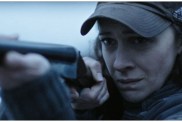Lee Gambin’s Secretly Scary column looks Altman’s Come Back to the Five and Dime Jimmy Dean, Jimmy Dean.
“You’re just like all the other warped and demented people out here…you’re just jealous, because I was the one who was chosen to deliver the son of James Dean!”
-Mona (Sandy Dennis)
The violent eruptions and the harrowing psychotic hollering that stabs at the dense hot thick air of a Woolworths stuck out in the middle of a dustbowl Texas town near Marfa, is what startles the audience when they settle in to watch auteur Robert Altman’s haunting Come Back to the 5 and Dime Jimmy Dean, Jimmy Dean. However it is the underlying oppressive desperation and rumbling mental and emotional frailty that unsettles, disturbs and forces the cracked psyche to the foreground, compelling us to face caged demons and buckled denial. The true terror lies in personally concocted deception and the refusal to exist in a world that is swollen with innocuous banality – and in a deranged and unhinged mind, the desire to lose oneself in the mystique of a fabricated realism (that of Hollywood as a great maker of myths) is a necessary copout and an essential alternative. This is what paints up the disturbed character of Mona, a woman tormented by self-inflicted alienation, overwhelming sadness, despotic ordinariness and a relentless devotion to personal detriment. Mona is an impressive creation in regards to a heightened theatrical sensibility; a monstrous neurotic who is a slave to ungodly suffrage. Played by Sandy Dennis with a hypnotic and frightening, manic, sweaty nervousness and schizoid rage, Mona is woman possessed by an idea and a purpose – to ensure that her deception is eternally incarcerated.
The perpetually captivating Dennis would make a career out of playing nutsy, jittery wrecks, always on the brink of some kind of emotional breakdown; and here in this intimate play adaptation, she gets to delve into incredibly dark territory that mirrors her Gorgon all-consuming spinster turned vulture-woman in director Altman’s psychological horror masterpiece delivered a decade earlier, That Cold Day in the Park (1969). In Come Back to the Five and Dime Jimmy Dean, Jimmy Dean, Dennis would take the bull by the horns in morphing into a woman eager to be “chosen” – to be accepted, loved, cherished, understood and most importantly, acknowledged for simply existing. Monas’s devotion to the James Dean fan club she has created is a testament to her insecurity as a human being, and the horror of losing herself in the fantasy extends to an abusive reactionary response in turning a perfectly healthy child into something unworthy of parental affection. In many ways, Mona’s son, who she insists is “retarded”, shares very similar traits to the phantom son concocted by the booze riddled horror shows that are George and Martha in Who’s Afraid of Virginia Woolfe?(1966). It is interesting to note that these two young men (one who physically exists but is stitched together by lies, and the other who is a make believe crutch) force their creators to re-examine their shattered mania, and are the spiritual glue that holds such damaged people together. These boys – Mona’s Jimmy Dean and George and Martha’s “son” – have the “privilege” of being an off screen character or a completely made up entity, and therefore the lies and delusions that they represent are physically realized by their Victor Frankensteins, who we, the audience will eventually be frightened by.

The interpersonal terror that shifts and manipulates the characters within the fabric of Ed Graczyk’s taut and mesmerizing writing, is the idea and complicated notion of delusion, and the frightening realization made poignant by the much repeated mantra: “deceiving to the eye”. Mona truly believes that her sensitive effete queer friend Joe (Mark Patton) is someone to fight for (“If God can’t accept him, than I can’t accept God”) but also someone to render invisible. When she denies the truth (that he is in fact the father of her son) she denies a superficiality that could deliver him from small town ostracism. The reason behind this denial is the legitimate monster of the piece: Mona’s obsession and devotion to an icon that she has recreated in order to validate her lonely and desperate existence. Mona explains that her passionate connection to movie star James Dean goes beyond fandom, and that her addiction to the Hollywood legend is “more than love”; it is a spiritual necessity.
Mark Patton (who would later play the tormented Jesse in A Nightmare on Elm Street 2: Freddy’s Revenge(1985)) delivers a touching tribute to a Texan sissy trapped by the ugliness of oppressive masculinity and the fevered violence that fuels it. With his spindly frame, fresh faced openness and ability to “be one of the girls”, Patton hits all the right notes in what truly is a tenderly measured performance. This is especially noted in both the scenes where he shares news of his gang rape (a graphic account made all the more harrowing by his bloodied face, spewing out frustrated rage) and his intimate quiet pleading for Mona to accept him as someone that she can validate. His female counterpart Joanne is played with insightful and enlightened elegance by Karen Black, an actress who would master roles ranging from crazed opportunist and gargantuan exhibitionist to frustrated loner and sympathetic fuck up. The extension of nuance in her showcase in the role of the transgendered Joanne is just as mesmerizing as Sandy Dennis’s mad woman, and both dance around the film’s keen observations into trauma and it’s thematic concerns with duality, transition, tragedy, exploitation, disarray and deafening defeat. When one of the women asks Joanne is her operation from man to woman “hurt”, she replies “Only when I think about it” –a poignant assessment on the intricacies of regret.
When Joanne enters the archaic 5 and Dime, the truth has arrived. The shattering of illusion creeps within the swelter of the heat and it slowly melts away the mirror of deception, the mirror of repression and the mirror of what once was. Robert Altman uses a literal mirror as both a distancing device and a view into the past, and when Joanne casts a reflection of her former self, it is always presented as a painful memory, as something far too difficult to confront. The horror of the human spirit and the evil that permeates the foggy air of mistrust and duplicity instill an ambience in Altman’s film that gives it a nightmarish quality, an orange-tinted freakshow that transitions from maddening conversation piece to communal bloodletting. Along with Sandy Dennis’s manic Mona and Karen Black’s haunted Joanne, the cast includes Kathy Bates as Stella-May, a boisterous Jill-do-well, who has married a wealthy oil prospector, hiding her deep rooted dissatisfaction (“I’m happy goddammit!”), Sudie Bond as Juanita, the God-bothering owner of the 5 and Dime, imprisoned by her failing store as well as her denial of her late husband’s disgrace and dishonor and Marta Heflin as the quietly sombre beautician pregnant with her umpteenth child, secretly the most “comfortable” of the lot.

One of the standout performances comes from Cher as James Dean disciple, Sissy. Here, this incredibly versatile and talented entity embodies the delicate complexities of a fragile character protected by an external bravado – a small town sexpot unsure of her appeal. She is a tough talking promiscuous waitress damaged by the insensitivities of men, and when she is cornered by the other women (prompted by Joanne) she is pushed into a tear soaked bloodletting. An emotional exorcism that is just as moving and as distressing as Mona’s and Joanne’s. Cher also manages the fiery sass of Sissy with effortless spunk, and matching this is her uncanny ability to throw herself into attack mode- spectacularly countering Sandy Dennis’s faraway instability. At the time of Come Back to the Five and Dime Jimmy Dean, Jimmy Dean, Cher was still mostly known as the comedic singer on her television show from the seventies with husband Sonny Bono, but here in this powerhouse role, she shines as a more than excellent dramatic actress, taking on meaty subject matter, honing in on extremities in emotional range with a sad-eyed depth that hits hard as the motion picture’s stronghold and backbone. Cher would later wow audiences and critics alike with her powerful performance as the drug addled mother of a boy with a facial disfigurement in Peter Bogdanovich’s unsentimental but remarkably poetic and lyrical Mask (1985) – a role that really should have garnered her an Academy Award.
Strangely the film’s promotional campaign pitched the film as a comedy, which it most certainly is not. Even the subdued comic elements are sombre in tone, incredibly black in mood and peppered throughout just to give the women a moment to breathe. This is heavy drama at its most dense and unsettling because it is a chamber production – a witch’s coven in the bleak setting of a dying American institution. The eeriness of the piece is a palpable force, a descent into mental illness and anguish and if it sits in the realm of Robert Altman’s three pieces “about” women, then it most certainly carries off from the emotionally stirring horror films that he delivered prior to this. Here, in this filmic adaptation of Ed Graczyk’s successful play, Altman has weaved together a grim detailing of the effects of emptiness and the vacuous wastelands of distress. Come Back to the Five and Dime Jimmy Dean, Jimmy Dean is the final feature to complete Altman’s horror trilogy “about” varied, complicated and dynamic women: the aforementioned That Cold Day in the Park dealt with sexual repression, and the sinister creep show 3 Women (1977) explored the monstrousness of identity theft. In Come Back to the Five and Dime Jimmy Dean, Jimmy Dean(a film with multiple purpose), the malevolence is born out of character and out of the frustrated desire to be known and to be recognized. When Mona delivers her dreamy soliloquy recounting her days on the set of Giant (1956), it is greeted at the end with Joanne holding her (one pure moment of acceptance) muttering “I chose you…” – this snapshot of human decency and genuine love is dismissed as the deluded Mona refuses to accept her moment in the sun being mundane and un-Hollywood. When she leaves the final scene, she re-enters the façade of Reata (the mansion in Giant), and when Joanne and Sissy rebirth in a sing-a-long of “Sincerely” by the McGuire Sisters, Mona reappears in Altman’s mirror set-piece, draped in her James Dean cult jacket and lost in memory – trapped by the past. The horror film manipulates us to understand the past, and sometimes it uses it to remind us about the dangers that can unfold in a present context, and in Robert Altman’s film, the past is a terrifying trap, while the present is an exorcism that will leave bruises and scar tissue with its recently possessed piled up exhausted sweaty messes.









